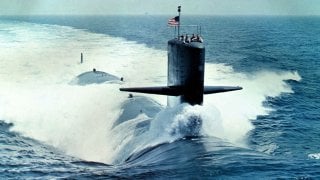Calling Tom Clancy: Navy USS Parche Spy Submarine Had 'Self Destruct Mode'
The USS Parche earned the title of the most decorated vessel in U.S. history for its critical Cold War espionage missions. Originally a Sturgeon-class attack submarine, the Parche was repurposed in 1974 to conduct clandestine reconnaissance on Soviet undersea communication cables, primarily in the Sea of Okhotsk.
What You Need to Know: The USS Parche earned the title of the most decorated vessel in U.S. history for its critical Cold War espionage missions. Originally a Sturgeon-class attack submarine, the Parche was repurposed in 1974 to conduct clandestine reconnaissance on Soviet undersea communication cables, primarily in the Sea of Okhotsk.
-Extensively modified with advanced surveillance equipment, the Parche excelled in wiretapping Soviet cables and retrieving missile fragments from the seabed.
-In 2004, it was decommissioned with an unprecedented array of honors, including ten Presidential Unit Citations. The Seawolf-class USS Jimmy Carter now carries on the espionage role that Parche pioneered.
Inside the USS Parche's Secret Cold War Missions
The USS Parche is said to be “the most highly decorated vessel in U.S. history.” Considering all the vessels that have served throughout U.S. history, from wooden schooners to stealthy littoral combat ships, in all the conflicts, from the War of 1812 to the War on Terror — to be the most highly decorated vessel in U.S. history is a pretty remarkable designation.
First commissioned in 1974, the Parche initially served as a Sturgeon-class nuclear-powered fast attack submarine. But after several years in the fast attack role, the Parche was chosen for an alternative function: clandestine reconnaissance. The target of course would be the Soviet Union – specifically, the Soviet’s underwater communications cables.
USS Parche Modified for its Deep Water Mission
To accommodate the USS Parche’s new role, the boat was modified extensively. The modifications allowed for superior maneuverability. Further modifications made space onboard for new gear including cameras, communications equipment, thrusters, new sonar arrays, and landing skids. To make room for all of the new gear the majority of the Parche’s torpedo tubes were removed, leaving the sub with just four torpedoes – which made the Parche extremely under-gunned.
Serving on the USS Parche was especially dangerous. Protocol dictated that rather than submit to Soviet capture, the Parche would scuttle itself, killing the entire 112-man crew, using the 150 pounds of HBX explosives on board. Fortunately, the Soviets were never able to force the Parche's hand.
The full breadth of the Parche’s mission profile is unknown. What we do know is that the Parche worked to tap Soviet undersea communications cables in the Sea of Okhotsk. The cable was important; situated along the ocean floor, the cable connected the Soviet Pacific Fleet’s Petropavlovsk-Kamchatsky base on the Kamchatka Peninsula to the Fleet’s headquarters in Vladivostok.
History Awards the Brave
The U.S. Navy did succeed in tapping the Okhotsk cable. In 1971, the USS Halibut, another espionage submarine, placed a large wiretap recording device on the cable. And when the Halibut was decommissioned, the Parche inherited the wiretapping role. In addition to operations in the Sea of Okhotsk, the Parche conducted wiretapping up near the North Pole and also in the Barents Sea.
In addition to wiretapping, the Parche was also tasked with recovering Soviet missile fragments from the seabed after test launches.
The USS Parche was decommissioned in 2004, after three decades of service. The submarine was scrapped in 2006 – but its flag was preserved and is now on display at the Puget Sound Naval Shipyard in Washington.
In all, “Parche would win a staggering amount of honors, including ten Presidential Unit Citations, nine Navy Unit Citations, and thirteen Expeditionary Awards,” Caleb Larson of the National Interest explained a few years ago. Indeed, the Parche was “the most highly decorated vessel in US history.”
The USS Jimmy Carter would fill the espionage role that the Parche left vacant. The Jimmy Carter is the third and final Seawolf-class submarine, which has been modified to become America’s “premier spy submarine.” The Jimmy Carter has been so heavily modified to fit the espionage role that the Parche left vacant, that the Jimmy Carter is sometimes considered its own subclass of submarine.
About the Author: Harrison Kass
Harrison Kass is a seasoned defense writer with over 1,000 articles published. An attorney, pilot, guitarist, and minor pro hockey player, he joined the US Air Force as a Pilot Trainee but was medically discharged. Harrison holds a BA from Lake Forest College, a JD from the University of Oregon, and an MA from New York University. He lives in Oregon and listens to Dokken. Follow him on Twitter @harrison_kass. Email the Author: [email protected]
All images are Creative Commons.


